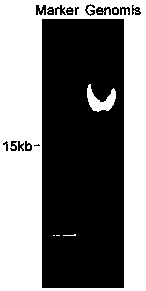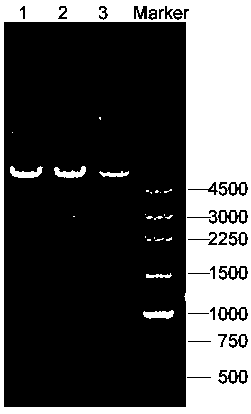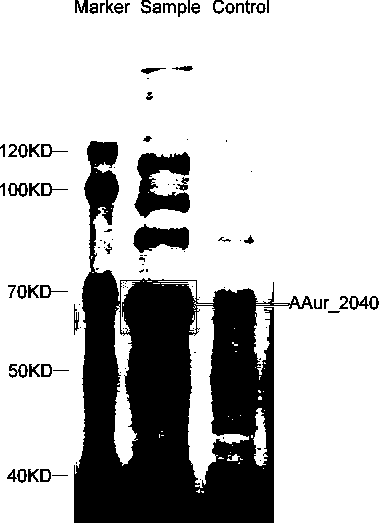A coding gene of swainsonine degrading enzyme and its application
A technology encoding gene and swainsonine, applied in the fields of biotechnology and enzyme genetic engineering, can solve the problem of not being a long-term solution
- Summary
- Abstract
- Description
- Claims
- Application Information
AI Technical Summary
Problems solved by technology
Method used
Image
Examples
Embodiment 1
[0019] Example 1 Arthrobacter sp. HW 08 Extraction of total DNA (Genomic DNA).
[0020] 1.1 Arthrobacter Expansion of sp. HW 08
[0021] Stored at -70°C under sterile conditions Arthrobacter sp.HW 08 was picked up with an inoculation needle and streaked on Luria-Bertani (LB) solid medium, cultured at 30°C for 48 h. A single colony was picked and transferred to LB medium for enrichment at 200 r / min and 30°C for 16 h. Then transfer 10% of the volume into inorganic salt culture solution containing 5% SW at 200 r / min, 30°C for 24 h, and take 500 μL of the supernatant to detect SW content by thin-layer chromatography (to verify whether HW08 bacteria can degrade SW ). The LB solid / liquid medium described here are common terms, media, techniques and methods for microbial research, for details, please refer to "Molecular Cloning Experiment Guide" (J. Sambrook, et al.). Unless otherwise specified, the techniques, methods, culture media, reagents, and medicines used in microbi...
Embodiment 2
[0025] Example 2 Obtaining of SW degrading enzyme coding gene AAur_2040
[0026] After analyzing the differential proteins obtained by Label Free proteomics, some differential protein genes were selected for analysis experiments, and a gene capable of degrading SW was screened out.
[0027] The primer sequence of gene AAur_2040 is:
[0028] F 5'-CCG GAATTC ATGCCTACCGCTAATGCTT-3'
[0029] (underlined as EcoR I restriction site, the gene sequence is SEQ ID No. 3);
[0030] R 5'- CCC AAGCTT CTAGCCGATAGTGGAGACGT-3'
[0031] (underlined as Hind III restriction site, the gene sequence is SEQ ID No. 4)
[0032] 50 μL amplification system: 10×LA PCR Buffer II (Mg 2+ Plus) 5 μL; dNTP Mixture (2.5mM) 8 μL; primers (20 μM) 2 μL each; total DNA obtained in Example 1 2 μL; LA Taq enzyme 0.5 μL; ddH 2 O30.5 μL. Reaction parameters: pre-denaturation at 94°C for 3 min, denaturation at 94°C for 30 sec, annealing at 49.5°C for 30 sec, extension at 72°C for 1 min, 35 cycles of amp...
Embodiment 3
[0036] Example 3 Expression of SW degrading enzyme AAur_2040 gene in Escherichia coli
[0037] 3.1 Construction of expression vector
[0038] The carrier pET32α (+) containing AAur_2040 gene in embodiment 2 is transformed into competent E.coilBL 21(DE3) expression bacteria were spread on the selective plate medium containing 50 μg / mL ampicillin for overnight culture, and 3 single colonies were randomly picked and inoculated in 3 LB liquid medium (containing 50 μg / mL ampicillin) in a test tube, cultivate until the bacterial density reaches OD 600 When it is 0.6, extract the plasmid and use EcoR I and hand Ⅲ double enzyme digestion ( figure 2 ) and sequencing methods to detect transformation results. Escherichia coli successfully transformed into the pET32α(+)-AAur_2040 plasmid is a positive transformant, which is E.coil BL 21(DE3) / pET32α(+) / AAur_2040.
[0039] 3.2 Induced expression
[0040] Will E.coil BL 21(DE3) / pET32α(+)-AAur_2040 transformants were cultured i...
PUM
| Property | Measurement | Unit |
|---|---|---|
| melting point | aaaaa | aaaaa |
Abstract
Description
Claims
Application Information
 Login to View More
Login to View More - R&D
- Intellectual Property
- Life Sciences
- Materials
- Tech Scout
- Unparalleled Data Quality
- Higher Quality Content
- 60% Fewer Hallucinations
Browse by: Latest US Patents, China's latest patents, Technical Efficacy Thesaurus, Application Domain, Technology Topic, Popular Technical Reports.
© 2025 PatSnap. All rights reserved.Legal|Privacy policy|Modern Slavery Act Transparency Statement|Sitemap|About US| Contact US: help@patsnap.com



